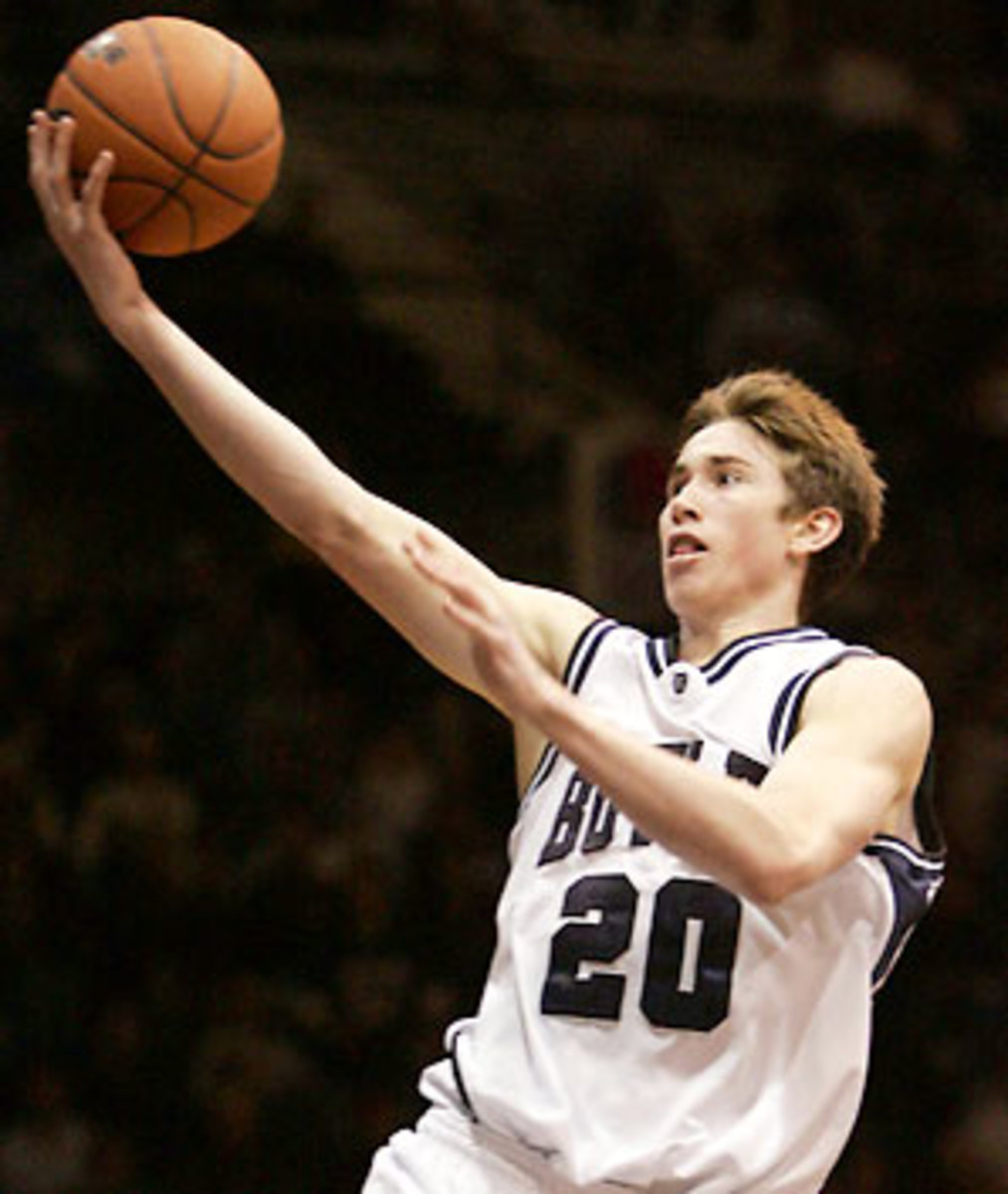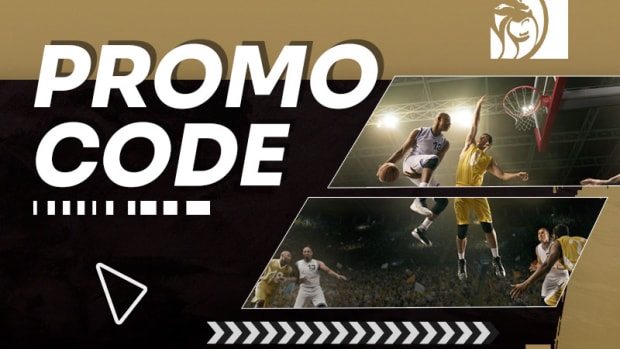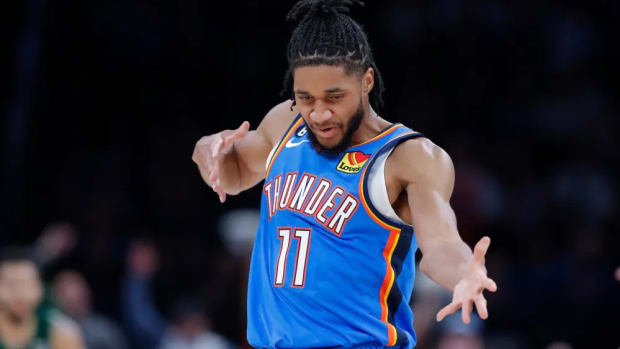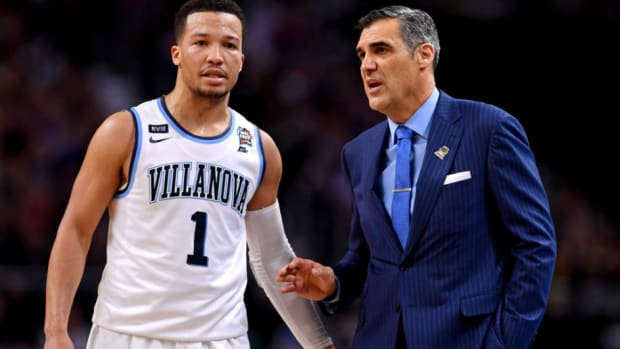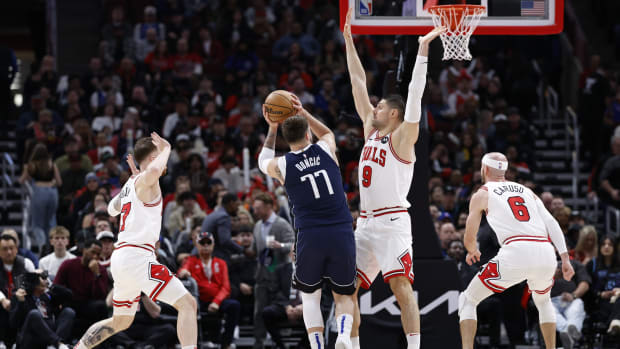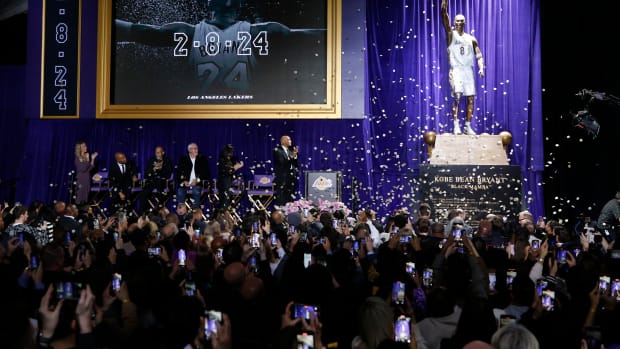NBA draft early entries: Evaluating each player's decision to turn pro
There is a flip side to that argument, though, and that story deserves to be told as well, with a sober analysis more in line with the realities of today's professional basketball world.
A few of these realities:
• Players have a limited window of approximately a decade or less to exploit their athletic prowess and maximize their career earning potential.
• Some players just aren't that interested in the academic side involved in being a student-athlete and would instead rather begin a professional career while helping support their family. That is their right, isn't it?
• The NCAA refuses to provide underclassmen with a fair opportunity to evaluate their options with the new May 8 early-entry deadline.
• Being drafted in the second round is no longer the death sentence it was once considered to be.
• The NCAA does not hold a monopoly on developing talent. The NBA Development League is an increasingly viable option for players looking for an alternative route to the NBA, as is Europe.
With that in mind, let's evaluate the decision made by each early entry.
Solomon Alabi, Florida State: Coming off knee surgery and already having redshirted his freshman season due to another injury, the risks of coming back for a fourth year were likely too great considering that he's almost certainly a first-round pick. Alabi surely could have developed his offensive game a bit more, but he also could have had a Jerome Jordan-eqse draft-hype-extinguishing year as well.
Cole Aldrich, Kansas: Aldrich could have been a top-10 pick in last year's draft, and after a disappointing early NCAA tournament exit and a season that did not get many NBA scouts a whole lot more excited, he's making the right choice to get his pro career started.
Al-Farouq Aminu, Wake Forest: Likely to be drafted somewhere in the 5-10 range, no one can question Aminu's decision, especially since he could have already been picked very high last year.
James Anderson, Oklahoma State: Not oozing with upside, but nevertheless one of the more productive wing players in college basketball, Anderson is entering the draft right as his stock has hit its likely peak following a Big 12 player of the year-caliber season.
Craig Brackins, Iowa State: Projected as a likely top-20 pick by most NBA teams we spoke with last year, Brackins was convinced by his college coaching staff to return to Iowa State last season, a decision that many questioned at the time. Following an underwhelming season, in a draft loaded with players at his position, his stock has plummeted deep into the second round, making him the poster boy for why staying in school isn't always the right decision.
DeMarcus Cousins, Kentucky: A surefire top-five pick and one of the most dominant interior presences we've seen at the collegiate level in quite some time, Cousins used his time under John Calipari wisely and is clearly ready to cash in on his immense talent.
Ed Davis, North Carolina: Coming off a mildly disappointing season and enduring the scare of his first serious injury, Ed Davis made the safe decision of going pro, which makes sense considering he's a likely lottery pick. He likely would have been far more ready for the NBA physically and skills-wise with another season at Carolina, but the risks of getting hurt again were likely too much to endure.
Derrick Favors, Georgia Tech: One of the most coveted prospects in this draft and a likely top-five pick, Favors had every reason to declare and didn't waste much time electing to do so.
Tiny Gallon, Oklahoma: Caught up in a scandal in which he reportedly took money from a financial adviser (as reported by TMZ), Gallon didn't seem to have much of a choice but to declare for the draft and start his professional career, as he likely had nowhere to return to.
Gordon Hayward, Butler: A smart, skilled and versatile player who is not oozing with potential, it's difficult to see how much higher Hayward's stock can rise after helping his team reach the NCAA final. He likely has enough fans among NBA GMs at this point to warrant a solid spot in the first round, which is tough to pass up when considering the risks involved in returning.
Xavier Henry, Kansas: Henry is clearly ready to be picked in the 10-20 range of the draft after handling his business perfectly on and off the court in his lone season at Kansas, making his decision hard to criticize. While he may not possess overwhelming upside, he appears to be an extremely safe pick for a good NBA team to add to its rotation and could develop into a terrific player.
Darington Hobson, New Mexico: Advanced in age after having bounced around quite a bit throughout his basketball career thus far, it's difficult to see how much Hobson could have improved on the well-rounded season he had for New Mexico, which was ranked in the top 10 for a good portion of the season. Not a particularly explosive athlete and more or less a finished product at this point, Hobson would have ran the risk of having his game completely picked apart by scouts had he elected to return to school. With that said, he's not guaranteed to go in the first round, although there are teams that like him in the 20-30 range.
Wesley Johnson, Syracuse: Turning 23 later this year with four years of college basketball under his belt and projected by some teams as top-five pick, this may have been the easiest decision of any player in this draft.
Dominique Jones, South Florida: Jones dominated the Big East in certain stretches this season, but he doesn't have a single NCAA tournament appearance to show for his career efforts, despite playing 3,500 minutes of college basketball. Although he can probably still stand to improve his jump-shot, it's tough to see how much more he realistically has to prove at the college level, making it difficult to fault him for feeling ready to get his professional career started.
Mac Koshwal, DePaul: Twenty-three years old and in a hopeless situation at DePaul, Koshwal made a wise decision to begin his professional career. Players with his physical tools and rebounding ability are coveted commodities worldwide. As the injuries he already suffered while playing NCAA basketball for free have likely reminded him, 6-10, 260-pound big men only have a limited window to begin setting themselves up for life after basketball.
Gani Lawal, Georgia Tech: Lawal already entered the draft last year and found himself on the first-round bubble, and appears to be in a very similar situation again this year. His strengths and weaknesses are well defined at this point and it's difficult to see how much he could move the needle on his draft stock with another season in Georgia Tech's chaotic system.
Greg Monroe, Georgetown: Monroe's sophomore season at Georgetown helped him develop into a better NBA prospect than he was the year before, and despite an early NCAA tournament exit, his stock is still solidly in the lottery territory, making this a pretty straightforward decision.
Daniel Orton, Kentucky: NBA teams are excited about Orton's prospects, despite the fact that he averaged only three points and three rebounds per game. That might be difficult for the casual fan to understand, but Orton lost a parent and already suffered serious knee problems before he even stepped foot on a college campus, making this decision quite a bit more complicated than some Kentucky fans realize. If Orton is drafted in the top-20 portion of the first round and is able to develop his skill-level on the job while drawing a paycheck, his situation won't be all that bad.
Patrick Patterson, Kentucky: Patterson leaves Lexington with his college degree in hand and a "likely lottery pick" projection, making this one of the easiest decisions on this list.
Larry Sanders, Virginia Commonwealth: Sanders is projected as a first-round pick, and thus doesn't have to explain his decision to anyone at this point. The college coach that recruited him left VCU last year for a higher paying job at Alabama, making this even more of a no-brainer for the long and springy shot-blocker.
Evan Turner, Ohio State: Projected as a likely top-10 pick in last year's draft, Turner nevertheless managed to up his draft stock even more this season, to the point that he'll likely draw some looks at No. 1 overall. He's probably given everything that can be expected and then some to Ohio State fans.
Ekpe Udoh, Baylor: Turning 23 in a couple of weeks and with four years of college under his belt already, no one can fault the decision of this potential top-10 pick.
John Wall, Kentucky: The favorite to be drafted first overall, Wall handled his lone season of college basketball with great class and now enters the NBA a more polished player than he was a year ago.
Elliot Williams, Memphis: While he may not be ready to play heavy minutes in the NBA right away, and may not even be a surefire first-round pick at this point, Williams' early-entry decision is far more complicated than most, as he has a sick mother that he feels obligated to take care of. He's surely a good enough prospect to start drawing an NBA paycheck immediately, and probably would have seen his role reduced significantly next season had he elected to stay at Memphis.
Jahmar Young, New Mexico State: There wasn't much choice involved here, as Young did not appear to be welcome back at New Mexico State following a late-night altercation with a police officer last month. Twenty-three years old and far from the NBA radar, Young will need to get his act together if he's to carve out a career in Europe, something his skill-set indicates is more than possible.
Luke Babbitt, Nevada: Babbitt is garnering interest from NBA teams picking throughout the second half of the first round, but he may have been able to establish himself as one of the best players in college basketball next season. Playing for a team that just lost starting point guard Armon Johnson to the NBA's early-entry list and playing in an off-the-radar conference such as the WAC, it's tough to criticize Babbitt too much if he feels like he's ready to get his pro career started.
Eric Bledsoe, Kentucky: Despite garnering some early hype as a potential lottery pick, Bledsoe's draft stock has cooled off a bit, to the point that he had to approach this deadline with serious caution. At the end of the day, Bledsoe decided to leave, especially with the top-rated point guard in high school basketball, Brandon Knight, headed to Lexington. Considering his tough background, it's difficult to criticize his decision.
Avery Bradley, Texas: Projected by some services as the No. 1 overall recruit in high school basketball, Bradley had a ho-hum freshman season on a team marred by inconsistency and reported chemistry problems. Undersized for a shooting guard and unlikely to see minutes at the point next season, Bradley elected to take the money and run, even if that might mean being drafted a lot lower than he might hope.
Derrick Caracter, UTEP: On the radar for years now since going toe-to-toe with Greg Oden in a game at Sonny Vaccaro's ABCD camp, Caracter's career can be described as more of a soap opera than anything at this point. He flashed sparks of potential despite looking largely out of shape in his lone season at UTEP (after transferring from Louisville). He will surely make good money wherever he ends up, be it the NBA, Europe or the Far East.
Jordan Crawford, Xavier: Crawford looked and played like he was ready to declare for the draft in November, and he was able to deliver the goods in March with a fantastic NCAA tournament performance. Seeing three different coaches in his three seasons in college thus far and with legitimate NBA buzz behind him at this point, it's difficult to criticize Crawford's decision to go pro.
Devin Ebanks, West Virginia: Coming off a fairly disappointing season individually in which he did not improve as much offensively as some expected, Ebanks' stock sits firmly on the first-round bubble at this point. With some reported friction going on behind the scenes at West Virginia, Ebanks apparently preferred to take his chances and declare for the draft regardless.
Charles Garcia, Seattle: A JUCO transfer who was denied entry at Washington, Garcia started off the season red hot, but cooled off dramatically as the year wore on. An extremely unique prospect as a skilled and athletic 6-10 power forward, question marks about Garcia's background have put his draft stock in flux. Whether playing another season at Seattle University would have helped matters is a highly debatable point that no one really has an answer for.
Paul George, Fresno State: One of the biggest enigmas in this class, George epitomizes the uncertainly of the NBA draft. A supreme talent who struggled to help his team win games in a mid-major conference, George is a raw player with huge potential who will likely intrigue NBA teams enough to warrant being selected in a solid spot in the first round, possibly very high.
Manny Harris, Michigan: Harris' decision is a difficult one to judge, as it largely depends on what his expectations were when he made it. He's no lock to be drafted at this point, but will clearly get every chance he needs to improve his stock and make an NBA team, either now or down the road. Only 20 years old and still very underdeveloped physically, there was a case to be made that another year in college could have helped, considering the lack of buzz around him. How different things would be at Michigan next year in John Beilein's system, though, is up for debate.
Armon Johnson, Nevada: The Nevada combo guard didn't wait very long to make his decision, plunging head first into the draft early on by hiring an agent. Although exceptionally gifted from a physical standpoint with his long arms and explosive athleticism, Johnson is a bit stuck between positions and fairly limited as a shooter and decision maker. He's likely banking on impressing enough in private workouts to earn a spot in the first round, and even if not, should be an attractive prospect early in the second.
Elijah Millsap, UAB: The brother of Utah Jazz forward Paul Millsap, Elijah turns 23 this summer and is on track to graduate after his fourth year of college basketball. His draft stock is still somewhat up in the air, though, as he only really emerged on the radar screen this year. A fifth year in college may or may not have helped his stock, depending on who you talk to, but Millsap obviously already has his mind made up. With one of his brothers being a certified NBA agent and another being an NBA player, he was in position to receive all the information he needed to make an accurate decision.
A.J. Ogilvy, Vanderbilt: Ogilvy put himself firmly on the NBA's radar screen with an excellent performance at the U-19 World Championship in Serbia back in 2007, but his college career ended up being somewhat of a disappointment after a promising freshman year. His minutes were down this season as there was apparently some friction between him and his coaching staff, while NBA scouts did not see as much improvement as they may have hoped. Ogilvy is a borderline NBA draft pick at this point who will have a significant market overseas, both in his native country of Australia and in Europe, where his skill-set may be more appreciated.
Terrico White, Mississippi: White's college career was short but fairly unconventional, going from unheralded prospect to being deemed a potential future star, while ultimately emerging as a marked disappointment this season. The reality is that he was probably somewhere in the middle of that wide spectrum all along, but in his mind he had almost no choice but to declare for the draft, seeing as how the perceived hype around him was appearing to fizzle. He probably could have used another year in college to work on his game, but he was in an unattractive situation at Ole Miss playing alongside a shot happy combo guard on a team that completely fell apart over the past few months.
Hassan Whiteside, Marshall: Drawing a significant amount of buzz from NBA scouts over the course of the season, Whiteside decided to strike while the iron was hot. He may have shot himself in the foot along the way, though, drawing a reputation for being lazy and incredibly immature, things that have clearly affected his stock. Whiteside probably could have used another year to mature physically and mentally before being thrown to the wolves of the NBA, but seemed to make up his mind already midway through the season. His career could go in many different directions from this point, even if there is no questioning how incredibly talented he is.
Willie Warren, Oklahoma: The rise and fall of Warren's draft stock -- from likely lottery pick to potential second rounder -- will be discussed ad nauseam in coming years. It serves as a cautionary tale for knowing when to cash in, as well as how not to act after deciding not to, even if we're only a couple of chapters into his story. With his future up in the air due to the damage that has been done to his draft stock, there was a legitimate case for Warren to come back and try to make up some of the ground he lost. At the end of the day, though, no one will describe his final decision as being much of a surprise.
Dee Bost, Mississippi State: Bost decided to stay in the draft despite not working out for any NBA teams, which likely means that there is more to this decision than meets the eye. Mississippi State's coaching staff reportedly did not know which way Bost was leaning until the final moments leading up to the deadline. Bost has already stated that he is prepared for the possibility of having to play in Europe next season, something that is clearly his right. Despite his inexperience and lack of perimeter shooting ability, there is indeed a market for athletic point guards who can create and score, if he's willing to adapt accordingly.
Armon Bassett, Ohio: Academic issues and other off-court factors reportedly played just as big a role in this decision as anything. Despite a terrific NCAA tournament performance in an upset over Georgetown, Basset may not be talented enough to overcome the red flags he's accumulated in his time at Indiana and Ohio. He'll still have an opportunity to make money at the professional level if he's willing and able to be on his best behavior.
Courtney Fortson, Arkansas: Fortson seemed to clash with coach John Pelphrey early and often in his short tenure at Arkansas, making his exit pretty unsurprising when you consider his advanced age. He'll likely be plying his trade in Europe or the D-League in the next few years, where he could still carve a good professional career if he manages to keep his feet on the ground.
Sylven Landesberg, Virginia: An extremely smooth, fluid and talented scorer, Landesberg's draft stock appears to be far from maturation at this point, making you wonder if he may have made a rash decision. A coaching change and ensuing conflicts over attending class appear to be the driving force behind him leaving, but there just doesn't seem to be a great deal of buzz behind him at this point. Thankfully for Landesberg, he does have an opportunity to acquire either an Austrian or an Israeli passport, which could be incredibly useful down the road if things don't work out.
Tommy Mason-Griffin, Oklahoma: As a 5-10 freshman combo guard who has struggled with conditioning issues, shot under 40 percent from two-point range and was the offensive catalyst of one of the most disappointing teams in college basketball, Tommy Mason-Griffin wasn't expected to enter the draft without even testing the NBA waters first. There is little buzz around his name at this point and may be even less of a market for his services in Europe this summer, making his decision to bolt in the face of adversity all the more questionable. If he's comfortable playing in the D-League next year, then he deserves everyone's blessings. But judging by his comments and actions, that does not appear to be the case at all.
Samardo Samuels, Louisville: One of the more surprising names on the early-entry list when the decision was announced, Samuels' difficult family situation in his native home of Jamaica is what ultimately pushed him in this direction. A former top-five high school recruit who has improved marginally since arriving at Louisville and doesn't appear to have the same NBA upside of other sophomores on this list, Samuels' decision to go make money at age 21 is clearly his prerogative. If unable to find a spot in the NBA, there is always a huge market in Western Europe for big men who can score inside the post, meaning he'll be just fine down the road, as long as he's willing to put the work in.
Lance Stephenson, Cincinnati: Stephenson would have declared for the draft back in the eigth grade if he had had the opportunity to, and his stock probably was higher back then than it is right now. College basketball was made for players like him, and he may be in for a rude awakening in the near future.






























